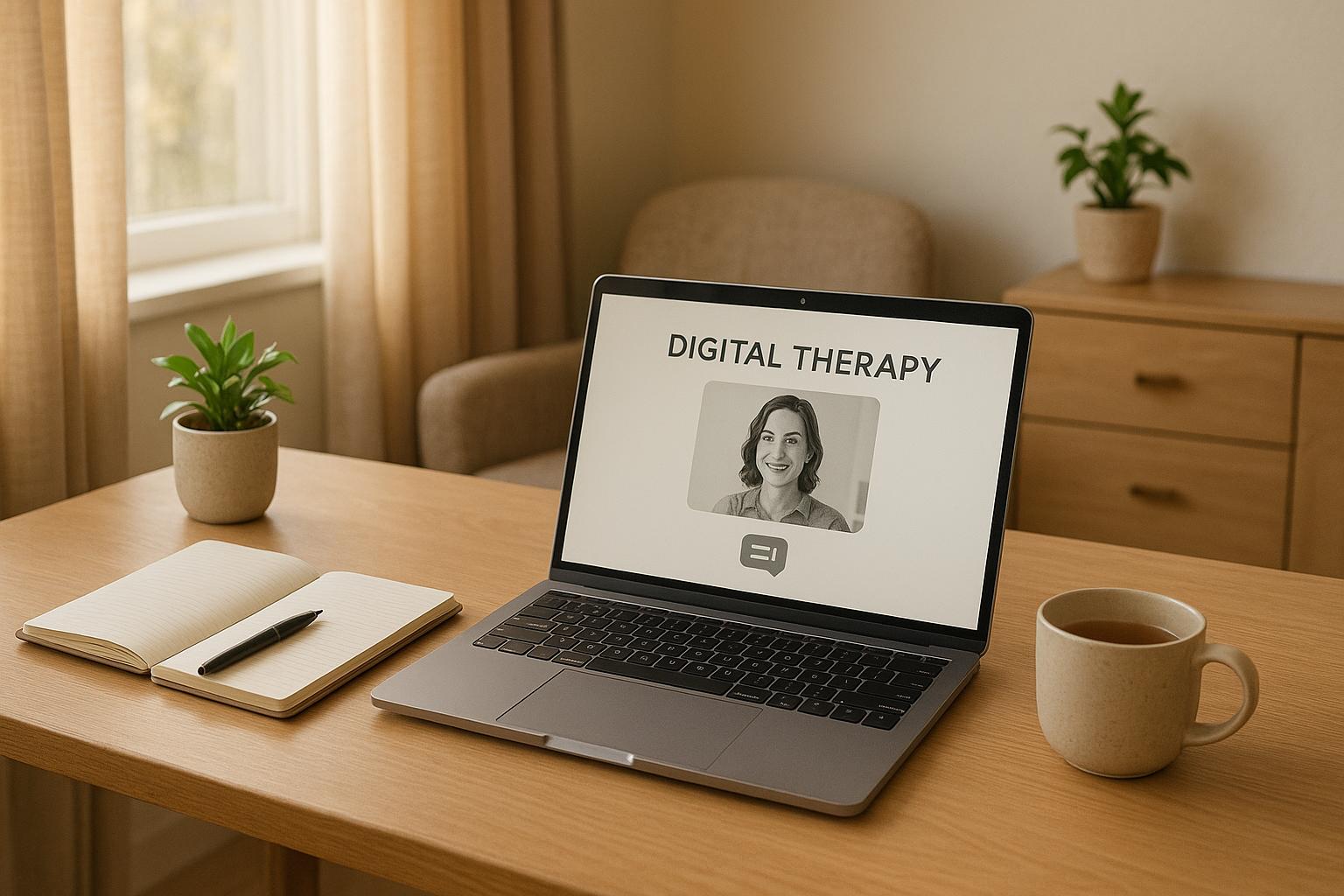Want to make the most of digital therapy? Start by focusing on these 8 practical tips:
- Set Clear Goals: Define specific issues and break them into actionable steps.
- Track Progress: Use tools like mood trackers and weekly reflections to monitor improvement.
- Create a Therapy Space: Pick a quiet, private spot and minimize distractions.
- Stick to a Schedule: Choose a consistent time for sessions that fits your routine.
- Use All Features: Leverage journaling, data reviews, and personalized check-ins.
- Try Short Sessions: Use small breaks for quick, focused mental health exercises.
- Provide Feedback: Rate sessions and reflect to tailor the experience to your needs.
- Integrate Therapy into Daily Life: Pair sessions with everyday tasks like your morning coffee or evening wind-down.
Why it matters: Digital therapy offers affordable, accessible mental health support with tools like mood tracking and guided exercises. By following these tips, you can build consistent habits, stay engaged, and achieve real progress. Ready to take the next step? Dive into the full guide to learn how to maximize your sessions.
How To Make The Best of Your First Online Therapy Session
Tip 1: Define Your Therapy Goals
Setting clear and measurable goals is a game-changer for staying focused and celebrating milestones during your digital therapy experience [1].
Pinpoint Your Main Concerns
Start by identifying the specific issues you want to address. Breaking your goals into smaller, manageable parts can make therapy feel less overwhelming and more productive. Here’s how you can approach it:
- Primary focus: What’s the biggest challenge you’re facing right now? Pin it down.
- Supporting goals: Consider other areas connected to your main concern that might need attention too.
- Desired outcomes: Visualize success – what does improvement look like for each goal?
"Aidx has been surprisingly human in identifying problems & asking the right questions. But faster! I got sucked into the conversation like I was talking to an educated & empathetic therapist & every suggestion sent me to where I needed to go. When you’re in quick need of help, attention & direction I think this will be an incredible tool to help people find & hear what they need so they can then take the next necessary steps." [1]
Once you’ve clarified your concerns, it becomes much easier to turn those goals into actionable steps and track your progress.
Keep Tabs on Your Progress
Tracking your progress is key to staying motivated and fine-tuning your approach. Aidx.ai makes this simple with its built-in planning tools, offering features like:
- Friday Wins & Monday Goal-Setting: Reflect on your accomplishments at the end of the week and set fresh goals for the next.
- Multi-channel reminders: Get nudges via email, WhatsApp, or Telegram to stay on track.
- Progress tracking: Monitor how your emotional state, confidence, and personal metrics evolve over time.
"I tried Aidx a few weeks ago and it was a really surprising experience! I shared a very specific topic and was guided through relevant questions, practical tips and actionable steps. The process was very natural and, above all, it was very useful. It was amazing to see how Aidx managed the specificities of the issue so well. Furthermore, also the way it was empathetic without being ‘robotic.’ How it dealt with the emotional content and, most surprising of all, how it had such an ethical approach. I still can’t believe the very human(e) and warm dialogue I was able to have with Aidx. Thank you for your lovely help, Aidx!" [1]
Thanks to its Adaptive Therapeutic Intelligence (ATI) System™, Aidx.ai adjusts your goals as your needs evolve, keeping you accountable and on the right path.
Tip 2: Set Up Your Therapy Space
Creating the right environment for your digital therapy sessions can make a big difference in how focused and connected you feel.
Choose the Right Location
Pick a spot that’s quiet, private, and well-lit. Avoid areas where interruptions are likely. To minimize distractions, consider using noise-canceling headphones, ensure your device is fully charged, and check that your internet connection is stable.
Using the same location consistently can help signal your brain that it’s time to focus on therapy. Pairing this setup with voice features can make your sessions feel even more interactive and convenient.
Use Voice Features
Aidx.ai’s voice features let you have hands-free, natural conversations tailored to your style. If privacy is a concern during sensitive discussions, you can switch to Incognito Mode for added comfort.
For those who want more flexibility, the Elevate plan ($20/month) offers unlimited voice chat sessions. It even integrates with messaging apps like Telegram and WhatsApp, so you can access therapy support wherever you are.
Tip 3: Build a Regular Schedule
Sticking to a regular therapy schedule can help you stay on track and make meaningful progress over time.
Pick Your Best Time
Find a time of day when you’re most open to self-reflection and free from distractions. Think about your energy levels and daily routine to choose a slot that works best for you:
- Morning sessions: Start your day with clarity and focus.
- Lunch break check-ins: Take a moment to reset during the middle of your day.
- Evening reflection: Wind down by processing the day’s experiences.
The key is to pick a time that fits naturally into your schedule. Once you’ve decided, use automated reminders to help you stick to it.
Set Up Session Alerts
If you’re using Aidx.ai’s Elevate plan ($20/month), you can take advantage of its reminder features to stay consistent.
"I found its timely and personalized email reminders to be useful to help me reflect on previous problems and also to remind me to seek help again when needed." – Cleo Brooks, Psychologist & Mental Health Clinician [1]
Set a 15-minute reminder before your session and use the built-in planner to track your progress and goals effectively.
sbb-itb-d5e73b4
Tip 4: Use All Available Tools
Digital therapy tools can significantly enhance your progress when you take full advantage of them. One key way to do this is by using the built-in features to document and reflect on your journey.
Write Daily Notes
Journaling is a powerful way to uncover patterns in your thoughts and emotions. With Aidx.ai’s journaling feature, you can:
- Track your daily mood.
- Document triggers that affect your emotions.
- Log moments of progress or insights.
- Write down questions to discuss in your next session.
Review Your Data
Regularly reviewing your data can provide valuable insights into your progress. Here are some key metrics to monitor:
| Metric Type | What to Track | Why It Matters |
|---|---|---|
| Emotional States | Daily mood ratings | Helps identify patterns and emotional triggers. |
| Confidence Levels | Weekly self-assessments | Tracks growth in specific areas over time. |
| Stress Indicators | Physical and mental symptoms | Aids in recognizing and addressing overwhelm. |
Aidx.ai’s Friday Wins feature is another great tool – it highlights your accomplishments and helps you celebrate progress, no matter how small.
Answer Check-in Questions
In addition to reviewing your data, take a moment to answer personalized check-in questions. These check-ins allow the ATI System™ to adapt its support specifically to your needs. By engaging consistently, you enable the system to use evidence-based techniques like CBT, DBT, and NLP to provide even more tailored and effective guidance. The more you interact, the better your therapy experience becomes.
Tip 5: Try Quick Sessions
Short digital therapy sessions can pack a punch, offering focused and impactful moments to address your mental health needs [2].
Make the Most of Short Breaks
You don’t need a full hour to see benefits – just a few minutes can make a difference. Here’s how you can use short breaks effectively:
| Time | Activity | Benefit |
|---|---|---|
| 5 minutes | Breathing | Eases immediate stress |
| 3–4 minutes | Mood check | Helps identify emotional patterns |
| 2–3 minutes | Mindfulness | Improves focus and awareness |
| 5–7 minutes | Reflection | Encourages positive reinforcement |
Pick one goal for each session. For instance, use a coffee break to practice deep breathing or take a few minutes at lunch to check in with your emotions. These small steps, when woven into your day, can lead to consistent progress.
Pair Sessions with Everyday Tasks
Incorporate mental health practices into your daily routine by aligning them with regular activities:
- Morning coffee: Take a moment to check in with yourself emotionally.
- Commute time: Use pauses, like waiting at a stoplight, to focus on your breathing.
- Lunch break: Reflect on how your day is going and what’s working well.
- Evening wind-down: Jot down a few wins or moments of gratitude before bed.
These quick sessions aren’t meant to replace longer therapy but can serve as a great complement, helping you stay on track between deeper sessions.
Tip 6: Share Your Experience
Giving feedback plays a key role in shaping your digital therapy experience. It helps AI platforms adjust their responses to better align with your needs, making each session more effective.
Rate Your Sessions
A study published in NEJM AI in March 2025 revealed that participants who consistently rated their therapy sessions saw noticeable improvements in their mental health. The research highlighted these symptom reductions:
| Mental Health Condition | Symptom Reduction with Regular Feedback | Control Group Reduction |
|---|---|---|
| Depression | -6.13 points | -2.63 points |
| Anxiety | -2.32 points | -0.13 points |
| CHR-FED | -9.83 points | -1.66 points |
When rating your sessions, focus on areas like how well the AI understood your concerns, the relevance of its suggestions, your emotional state afterward, and the overall effectiveness of the techniques provided.
Reflect on Past Sessions
Set aside 10–15 minutes each week to review your sessions. Look for recurring themes, pinpoint techniques that worked well, and identify areas that could improve. Once a month, take a broader look at your progress toward your therapy goals. This regular reflection ensures that every session adds value and helps refine your digital therapy journey.
"Fine-tuned Gen-AI chatbots offer a feasible approach to delivering personalized mental health interventions at scale, although further research with larger clinical samples is needed to confirm their effectiveness and generalizability."
- NEJM AI, March 27, 2025 [3]
Conclusion
Digital therapy is proving to be a practical and effective way to access mental health support, combining ease of use with consistent engagement.
The numbers speak volumes: 75% of people are open to AI-driven mental health support, and men are three times more likely to choose AI therapy over traditional human therapists [1]. With half of those seeking therapy struggling to find available professionals [1], AI-powered platforms step in to fill the gap – offering immediate access at roughly 80% less cost than traditional therapy sessions [1].
To make the most of your digital therapy experience, focus on these actionable steps:
- Define clear, measurable goals and track your progress regularly.
- Set up a dedicated space that helps you stay focused during sessions.
- Stick to a consistent schedule with planned check-ins.
- Take advantage of available tools, such as journaling and progress tracking features.
- Opt for shorter sessions when your time is limited but consistency matters.
- Share feedback to improve your overall experience.
Incorporating features like voice chat, goal tracking, and regular check-ins can help establish a sustainable mental health routine that works for you.
Mental health professionals are also recognizing the benefits of these platforms. Cleo Brooks, a psychologist and mental health clinician, shared her thoughts on Aidx:
"As a mental health professional committed to supporting individuals who struggle with how their thoughts and feelings impact them, I was intrigued about the concept of Aidx. After trying it for myself I have found that it has had a positive influence on how I approach my own issues and difficulties…I would recommend Aidx to anyone, and I can see how it could be a great tool and addition to the experience my own clients could have." – Cleo Brooks [1]
FAQs
How can I set therapy goals that are both realistic and achievable?
To create therapy goals that you can realistically work toward, consider using the SMART framework. This means your goals should be Specific, Measurable, Achievable, Relevant, and Time-bound. For instance, instead of saying, "I want to feel less stressed", you might set a clearer target like, "I will spend 10 minutes practicing mindfulness three times a week for the next month."
It also helps to break bigger goals into smaller, actionable steps that feel doable and align with what matters most to you. Checking in on your progress regularly and making adjustments as needed can keep you motivated and moving in the right direction.
How can I stay consistent and engaged with digital therapy?
To maintain consistency and stay engaged with digital therapy, start by identifying specific, realistic goals that align with what you hope to achieve. Set up a quiet, distraction-free space where you can fully concentrate during your sessions. Use the platform’s tools, such as progress trackers or journaling options, to keep tabs on your development and reflect on your experiences. Treat your therapy sessions as a priority by scheduling them at regular intervals, much like you would with traditional, face-to-face appointments.
How can giving feedback enhance your digital therapy experience?
Sharing feedback during your digital therapy sessions can make a big difference in how effective and helpful they are. It allows your therapist or AI-powered coach to better understand what’s clicking for you and what might need a tweak, creating a more personalized and meaningful connection.
When you share your thoughts openly, the platform can adjust its approach to suit your needs, helping you stay on track with your goals. Plus, open communication builds trust – a crucial element for making real progress in therapy.



